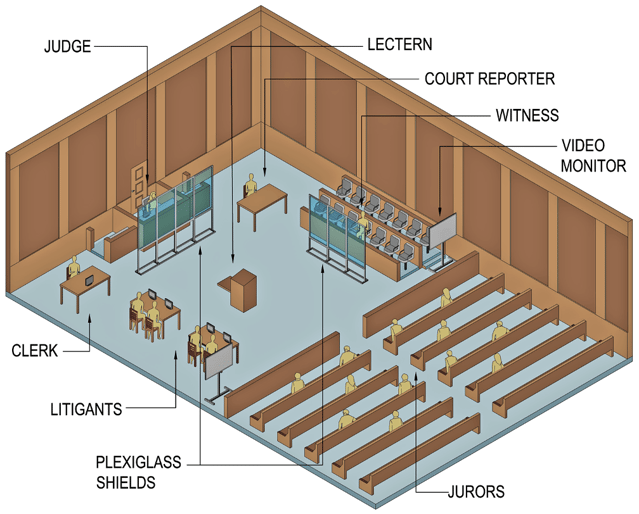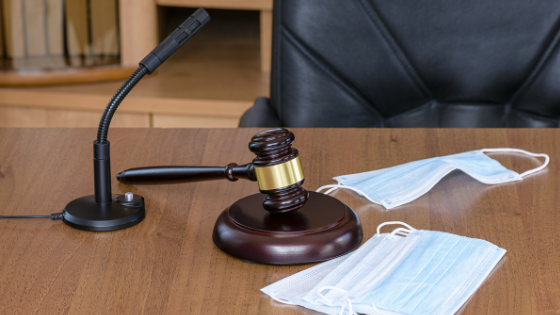In a previous blog, I wrote about one way a courtroom proceeding could be held while still observing social distancing protocols during the COVID-19 pandemic. Since then, I’ve come across other potential solutions that have been implemented by courts around the country. In this blog, I describe one such adaptation that was presented during a webinar on the reopening of businesses and government buildings.
One of the webinar presenters, a court clerk from Texas, described an approach she called “reversing the courtroom.” While the entire courtroom is not reversed in this approach, some of the spaces for court participants – including, the judge, courtroom staff, attorneys, litigants/defendant, the jury, and public – are switched with other spaces.
Let’s look at these switches one space at a time.
Gallery
The gallery, or spectator area, is where the public sits to observe proceedings. The court in Texas decided to move the spectators out of the gallery, and actually out of the courtroom altogether. However, because our justice system is designed to be transparent and most court proceedings must be open to the public, the court had to find an alternate way to provide seating for the public.
The solution they came up with was to move the spectators to a different courtroom. Large video monitors were brought into this secondary courtroom to display a closed-circuit broadcast of the proceeding to the spectators.
With the gallery area now empty of spectators, the gallery space could be used to seat the jury. The gallery in this Texas courtroom, as is the case in most courtrooms, is a large enough area to be able to spread out the 12 jurors and alternates with at least six feet of distance between them.
Modern court proceedings often include evidence displayed electronically on video monitors. To allow the jury to view this evidence, two large-screen video monitors were placed in front of the jurors on both sides of the gallery.
Jury Box
Moving the jurors into the gallery freed the jury box to be used as a witness stand. In the Texas courthouse, the witness box was directly adjacent to the judge and did not allow the required six feet of distance between the two spaces. Placing the witness in the jury box solved this distancing problem.
Many jury boxes today are equipped with video monitors so jurors can view the evidence. Using the jury box as the witness stand allows a witness to view evidence on one of these monitors. If the jury box is not equipped with monitors, a portable monitor in front of the jury box should be provided for the witness.
Plexiglass screens were also installed in the Texas courtroom in front of the jury/witness box. This provides some protection between the attorneys in the well area and the witness, allowing attorneys to approach the witness box at a relatively safe distance to question the witness directly.
Jury Deliberation
The jury deliberation room in this Texas courthouse was too small to be able to accommodate the jurors with social distancing protocols in place. Instead, the court used the jury assembly room for jury deliberation, arranging tables in a large square and spacing the chairs around it. The jury assembly room worked well because it had restrooms and a service area self-contained within the space. Another possibility would be to use a large conference or training room, which often have those self-contained support spaces as well.

Example Courtroom Layout with Social Distancing
Well Area
It is vital that lines of sight are maintained between all participants in the courtroom. The litigants, especially the defendant, need to have a clear view of the witness. The jurors need to be able to see the face of the witness, as well as the faces of the litigants. The judge needs to be able to see, and be seen by, everyone.
To achieve these lines of sight in the modified courtroom layout, the litigants’ tables in the well area were turned 90 degrees to face the witness in the jury box. The tables were also set back slightly toward the wall opposite the jury box so that there were lines of sight between litigants and jurors in the gallery and between litigants and the judge on the bench.
A lectern with electronic evidence presentation technology was set up between the litigants’ tables and the jury box. Many courtrooms with evidence presentation technology have underfloor chases to conceal the wires and cables. Most underfloor wireways were designed for the more traditional location of litigants’ tables and lecterns, with access boxes in those locations. With a layout modified for COVID-19 considerations, it may be necessary to run those wires and cables on top of the floor. Be sure to use plastic covers to manage these wires and to prevent tripping hazards.
The court reporter’s table was set up near the back on the jury box so the reporter could hear the witness and the attorney clearly. The courtroom clerk’s table was placed on the other side, opposite the bench.
Judge’s Bench
The only person remaining in place in the modified courtroom arrangement was the judge. Plexiglass screens were installed directly in front of the judge’s bench to provide protection and to allow the judge to directly address the attorneys in the well and the witness in the jury box. Because judge instructions, attorney questions, and witness testimony need to be clearly spoken and heard, masks are not always worn in the courtroom. Therefore, plexiglass screens provide important protection for all involved.
The Post-COVID Courtroom
It may be difficult to imagine right now, but there will be a time when social distancing and masks will no longer be necessary in the courtroom. However, some of the ideas generated in response to the pandemic may still be useful going forward. For example, courts may continue to put some spectators in another room to view the proceedings remotely, which is especially useful for trials that garner a good deal of publicity and attract many spectators. Other courts may find that expanding the use of video for proceedings can help the efficiency of their court.
Necessity is the mother of invention. It may turn out that some of the approaches courts have adopted during the pandemic will continue long after the pandemic runs its course.
_________________________________________
To learn more about courtrooms, click on the image below for our Courtroom and Chambers guide.




.jpg)
.jpg)
.jpg)
.jpg)
.jpg)
.jpg)


.jpg)
.jpg)
-1.jpg)
.jpg)
.jpg)
.jpg)
.jpg)
.jpg)

